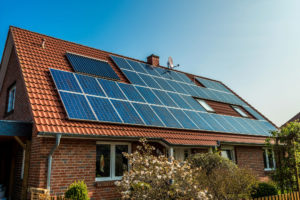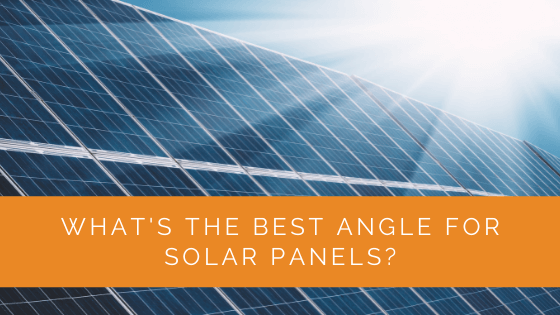When it comes to harnessing the sun’s abundant energy, one critical factor often overlooked is the angle at which solar panels are installed. The angle not only determines the effectiveness of energy collection but also plays a pivotal role in optimising the returns on your solar investment. In this article, we delve into the science of solar panel angles, shedding light on how adjusting them according to your location and the seasons can significantly impact your energy production. Discover the secrets of the perfect solar panel angle to maximize your savings and minimise your carbon footprint as we explore solar power’s benefits, limitations, and transformative potential.
Contents
- 1 Key Takeaways
- 2 What Angle Works Best for Solar Panels?
- 3 What Are the Advantages of Going Solar?
- 4 Why is Solar Good for the Environment?
- 5 The Limitations of Going Solar
- 6 Solar Panels and Their Effects on Your Wallet
- 7 Case Study: Optimising Solar Panel Angles for Maximum Efficiency
- 8 Expert Insights From Our Solar Panel Installers About the Best Angle for Solar Panels
- 9 Discover the Power of Solar with Solar Panels Network
- 10 Conclusion
Key Takeaways
- The angle at which solar panels are installed significantly impacts their energy generation potential. To maximise sunlight exposure, panels should ideally be tilted at a perpendicular angle (ninety degrees) to the sun’s direction. Adjusting the angle based on the time of day and season is essential for optimal energy collection.
- Going solar offers several advantages, including reducing electricity bills, increasing property value, and minimising environmental impact by reducing reliance on fossil fuels. Solar power can also provide significant financial returns, with average users seeing 20% or more returns.
- While solar power has numerous benefits, it has limitations, such as the reliance on sunlight for energy generation and the high upfront installation and maintenance costs. However, the long-term savings and environmental benefits outweigh these drawbacks for those committed to reducing their carbon footprint.
What Angle Works Best for Solar Panels?
The angle at which you place your solar panel is a prime determinant of whether your panels will gather enough energy to generate sufficient power. This factor is pretty much a given, but the amount of sunlight directly focused on your solar panels is oriented by the angle at which you arrange them.
The ideal angle of tilt that will ensure the panel collects enough sunlight to convert into viable energy would usually be at a perpendicular angle (ninety degrees) between the sun and the panel’s surface.
When setting up a solar-powered panel, you must pay attention to a few things. Paying close interest to factors such as your roof, the best time of the day, and the season will ensure you reap the best benefits in the investment.
Depending on your location’s climactic season, you would have to shift your solar panels to receive optimum sun rays and collect enough energy to power your home or workplace. Changing the angle aptly, according to the time of the day and the season, significantly depending on how much sun rays your area receives, would be a literal game-changer.
In Britain, a latitude of 51.15 degrees, 65 degrees in summer and 30 degrees in winter would allow you to maximise sunlight time.
What Are the Advantages of Going Solar?
To start, switching to solar power will take a great weight off of your electrical expenditure. Sure, as an inexhaustible source, solar energy benefits the ecosystem and the environment, but it is a notable investment.
In a fast-moving culture of NFTs and stock and bitcoins and whatnot, solar power is a formidable competitor that could garner significant gains for you, with your average user seeing 20% or even more returns!
Along with assisting you in shrugging off the brunt of large bills, solar energy is also notorious for increasing the overall value of your property. If you decide to move or sell your property, you will realise it has become a gold mine.
Why is Solar Good for the Environment?
Solar energy will enable you to drastically reduce what otherwise would have been a rather heavy carbon footprint on your environment’s resources. Switching to solar power ensures that you don’t draw from other exhaustible forms of energy, such as fossil fuels.
When you use solar power, you are giving excessive power back to the grid, allowing you to reduce your environmental footprint and serving the equivalent of planting over a hundred trees annually.

The Limitations of Going Solar
Like everything under the sun (pun intended), going solar also has its set of detriments. The drawbacks aren’t much to be considered if you are committed to reducing your carbon footprint and playing your part in chipping in for the environment.
Here are a few things you would have to consider before setting out to make the epic change:
It is a no-brainer, but your solar equipment would only work at total capacity when the sun is out. Although this renewable energy source is a big winner, the maintenance and installation costs that come with it are pretty steep.
Solar Panels and Their Effects on Your Wallet
Solar power in itself can be considered a sizeable investment opportunity. When you opt to go solar, not only do you do a big one for the environment, but you will also be able to ‘make bank’ by selling any additional power back to the grid.
A significant factor to consider when adopting a solar-powered energy source is the maintenance costs and the instalment figures; it will eventually cost you a considerable sum.
However, the fact is that you would be saving so much more than you would initially have if you had gone the good old-fashioned way of powering your home or workplace.
Case Study: Optimising Solar Panel Angles for Maximum Efficiency
Background
At Solar Panels Network, we continually strive to provide tailored solar solutions that maximise efficiency and return on investment for our clients. In a recent project, we worked with a homeowner in southern England who was keen to install a solar panel system but was unsure about the optimal angle for their setup. The goal was to ensure maximum energy capture throughout the year, leveraging the best practices in solar panel angling.
Project Overview
Our objective was to design a solar panel system that would provide the highest possible energy yield, considering the specific geographical and climatic conditions of the location. The client was particularly interested in understanding how different angles would affect energy production and long-term savings.
Implementation
- Site Analysis: We conducted a comprehensive site analysis, including roof orientation, tilt, and potential shading issues. We also considered the local climate data to determine the optimal seasonal adjustments.
- Angle Calculation: Using advanced simulation software, we calculated the ideal angles for each season—around 30 degrees for summer and 40 degrees for winter—to maximise solar exposure.
- Installation: Our team installed a system with adjustable mounts, allowing the homeowner to alter the panel angles seasonally. We also provided detailed guidance on when and how to make these adjustments for optimal performance.
- Monitoring and Support: We installed a monitoring system to track energy production and provide real-time feedback. Our team remains available for ongoing support and adjustments as needed.
Results
- Increased Energy Yield: The optimised panel angles resulted in a 15% increase in energy capture compared to a standard fixed-angle setup.
- Enhanced Savings: The client experienced significant reductions in their electricity bills, aligning with our projections for a faster payback period.
- Client Satisfaction: The homeowner expressed high satisfaction with the performance and the comprehensive support provided, appreciating the detailed insights into maximising their system’s efficiency.
Summary
This case study highlights the importance of carefully considering the angle of solar panel installations. By implementing a tailored approach, Solar Panels Network successfully increased the energy efficiency of the system, resulting in substantial savings for the client. This project underscores our commitment to providing customised solar solutions that meet the unique needs of each client, ensuring they achieve the maximum possible benefits from their investment.
Expert Insights From Our Solar Panel Installers About the Best Angle for Solar Panels
The optimal angle for solar panels is crucial to maximising energy output. In the UK, the best results are often achieved with a tilt between 30 to 40 degrees, adjusted seasonally. This ensures that the panels capture the maximum amount of sunlight throughout the year, optimising both efficiency and financial returns.
Senior Solar Energy Specialist
Many homeowners overlook the importance of adjusting the angle of their solar panels. Even a slight tilt adjustment can significantly impact the amount of solar energy captured, especially in regions with variable weather patterns. It’s an essential consideration for anyone looking to get the most out of their solar investment.
Renewable Energy Consultant
Positioning your solar panels correctly is as vital as choosing the right system. We always advise our clients to consider both the angle and orientation of their panels. A well-planned installation can lead to substantial savings and a faster return on investment, making the most of the UK’s solar potential.
Lead Solar Installation Engineer
Discover the Power of Solar with Solar Panels Network
Are you navigating the world of solar installations? Look no further than Solar Panels Network, the UK’s trusted partner in harnessing the sun’s potential. Our dedication goes beyond just installations; we’re on a mission to transform how homeowners and businesses across the UK perceive and utilise energy. By choosing us, you’re reducing your carbon footprint and making a smart financial move that promises savings for years ahead. Contact us today and embark on your solar journey.
Conclusion
Solar power is a formidable renewable energy source that will reap benefits for your finances and the environment. A great investment with large returns allows you to reduce your total carbon footprint on the world.
Switching to this novel and innovative form of energy will allow you to reap its benefits over the years. Ensuring you sleep peacefully, knowing that you tried to reduce the detrimental effects on the ecosystem.
About the Author
Solar Panels Network stands at the forefront of solar energy solutions, driven by a team of seasoned solar engineers and energy consultants. With over decades of experience in delivering high-quality solar installations and maintenance, we are committed to promoting sustainable energy through customer-centric, tailored solutions. Our articles reflect this commitment, crafted collaboratively by experts to provide accurate, up-to-date insights into solar technology, ensuring our readers are well-informed and empowered in their solar energy decisions.

